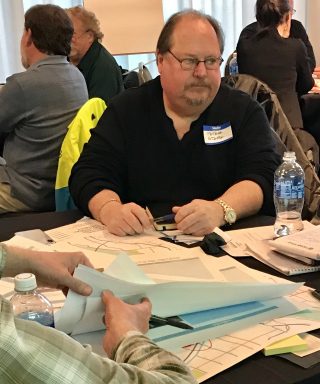
(Photo: J. Maus/BikePortland)
As the City of Portland looks to create a usable, low-stress cycling network in the central city, one of the toughest places to make it a reality will be the Central Eastside Industrial District. An area hemmed in by massive freeway infrastructure with a legacy of heavy industry and freight-dependent businesses, the CEID is in many ways the lynchpin of the Central City in Motion project.
One of the people standing in the middle of discussions about how to plan for the future of this district is Peter Stark.
Stark is a licensed architect who owns his own design and planning firm. He’s also one of Portland’s most well-known activists. Stark’s many civic endeavors include a position on the board of Portland Streetcar Inc., and he’s the founder and board chair of the Cornell Road Sustainability Coalition. In the Central Eastside, Stark has been a key player for over 17 years. He’s a past president of the Central Eastside Industrial Council and currently on the board as well as being the executive director of the CEIC’s Transportation Policy Advisory Committee.
I caught up with Stark after a meeting of the Central City in Motion in project last week to ask him about how he sees the future of bikes and freight in the Central Eastside.
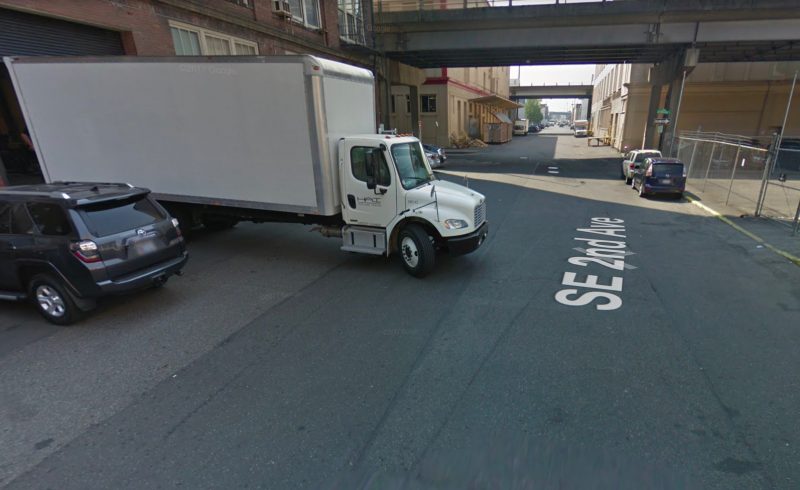
How are you feeling at this point about the City’s plans for improving bikeways in the CEIC?
“We’ve said from the very beginning we are strong supporters of improved bicycle and pedestrian movement in the city because we realize we have limited capacity for freight. We need to open up the roads for better freight movement. So providing an opportunity for people to get out of their cars and use these other systems, is a big benefit for us. Anbd we have many employees that love to get to their jobs through those facilities. The problem we’ve had is that, and the city doesn’t understand this, it when it comes to freight what we’re really worried about is hurting people. So I keep pushing the idea that we ought to have dedicated alignments for those uses [freight and bicycles] so we don’t have a conflict. The minute you put them on the same road it’s always a question of, what happens when somebody gets killed?”
What about the contention that the district is changing. The CEIC says freight is so important today, but what about five years from now?
“As we continue to densify and increase employment, you’re going to have more freight, not less. They’ll be smaller, but you’ll have more delivery, more needs to move goods and services in and out.”
You’re talking about freight delivery. But what about the industrial land-use? Isn’t that changing?
“Yes and no. Talk to New Seasons, they just made a substantial investment here in the district. And they are freight-centric. This is a distribution center for them. You’ve got a lot of companies that have really invested in this district. Now, you can kick them out and maybe eventually they’ll find they can’t move [their goods] in or out. But I’ve always believed you want to evolve the district, rather than just cut it off. I try to move the district towards little changes. A little bit at a time.”
Advertisement
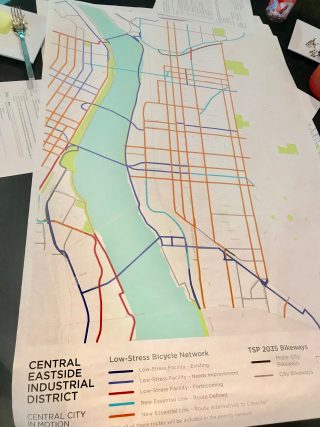
You say it’s a freight and industrial district for the next 10-20 yrs, and the City says it also has to be a place to move vulnerable people safely through the streets. Is there a way to make these things coexist?
“Yes, but it doesn’t mean you put those people on the same road as the roads that have been desginated as freight. SE 7th is a good example. I’ve been working with Ryan [Hashagen, of Icicle Tricycles] and Franklin [Jones, of B-Line Urban Delivery] for quite a few years and they’re a bicycle business that moves goods and services. They can be on those freight streets because they understand the importance of mixing safely. But when you see that slide [referring to a PBOT slide in the meeting] with that little kid with her mom and her groceries on the back — and you put that on a street where you have freight — that’s asking for disaster. And I’m worried about it.”
So you want separate streets for bike and freight. Then the question becomes, which mode gets which streets?
“Well, 7th hasn’t always been a bike alignment. The city seems to always put bike alignments on some of the major arterials. You look at a street where there’s a sharrow and you’ve got a bike in a neighobhrood… A lot of your little kids are going to use that street over a bike lane that’s been painted on the ground next to a big truck that’s coming by. Again, and I’m just worried that we haven’t talked about it enough, but MLK/Grand Avenue is our corridor. I would love to see us slow the traffic down there, make that our commercial corridor; put the Green Loop right on our commercial corridor [the Green Loop is currently planned to be on 6th and 7th].”
Do you feel the same way about parking? That the City’s plans for biking can coexist with existing parking capacity?
“When you talk about transitions and increased density. Think of it in terms of increased employment density and not just residential. That’s the model in the Central Eastside. It’s not a mixed-use district as much as it’s focused on increasing employement. The reason we’ve been pushing this industrial model – and by the way we all know it’s really a new urban-industrial-hybrid-creative-services kind of a thing, not smokestacks — the truth is, parking is going to continue to be going away. There’s no way of avoiding it. We’ve got to provide solutions that provide for the employment increase transitionally. So we’re going to continue to fight to save parking if we can, and realize that over time it will go away. It’s inevitable. It will probably become freight loading and unloading.”
Or maybe it’ll become space for protected bike lanes?
“Or both! I think we have more in common with the bike community than less. We have more interests that are the same than not. Finding a solution is what we’re hoping to be able to do.”
— Jonathan Maus: (503) 706-8804, @jonathan_maus on Twitter and jonathan@bikeportland.org
Never miss a story. Sign-up for the daily BP Headlines email.
BikePortland needs your support.


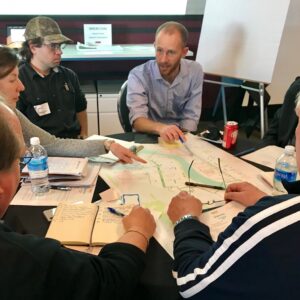
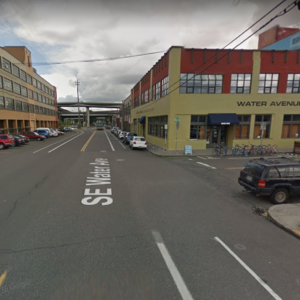

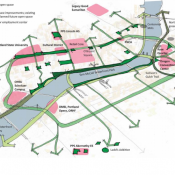
Thanks for reading.
BikePortland has served this community with independent community journalism since 2005. We rely on subscriptions from readers like you to survive. Your financial support is vital in keeping this valuable resource alive and well.
Please subscribe today to strengthen and expand our work.
I think the freight interest and the cycling interests are strongly aligned. We both want to get as many single trip single user car drivers off the street as possible — it’s best for both of us. And I do think freight and bikes could mingle on the same roads — we already do on SE 17th and while riding next to the large trucks isn’t my favorite thing, it does work. It would work even better if there was no car parking on that street and the bike lanes were physically protected. The same could be true for SE 7th (or SE 6th). The SE 7th bike lane is terrible, because of all the car parking. If the cars weren’t there we could have a nice bike lane, physically protected, and a bit more room for the commercial traffic.
What if those streets became more narrow ?
What would Utrecht do?
First, they would turn one N/S route (Grand, MLK, 6th ave, or 7th ave) into a full-on bicycle thoroughfare:
What’s great about the CEID is that even one complete bicycle street would essentially be a “complete” network for the neighborhood (since if it runs the length of 6th, all the shops on Grand and MLK are only a block away). This would probably cause mode to EXPLODE, thus kicking off a virtuous cycle of demand for an actual complete network.
They’d drink a Heineken.
I don’t know, but here are three options:
1) design Interstate MAX so UP isn’t effectively forced to move their intermodal facilities from Albina to Brooklyn Yard;
2) build a quarter mile freeway connector so Brooklyn truck traffic doesn’t have to use MLK/Grand;
3) ignore freight needs and complain when nothing works for any mode.
4) Put toll booths on SE 26th and on Holgate, and then build us some kick-ass bike facilities.
Separate!
I love local freight; I support freight needs in the CEID. But, so much of our trucks in this area are pass through trucks hauling regional and international freight – Intermodal containers and the regional truckers that are not looking to deliver in or to this area, but instead, drag their freight and dead-head containers through it. These truckers use cut-through, aggressive driving techniques to get through this area on/off I-5, MLK, 7th, 11th/12th, Division/Pl, Interstate, Going, etc. Any way they can cut through to get their empty container up to a rail yard faster, they will do. Who knows if they are even legal or safely operating, we know they are heavily polluting. These guys are anti-thetical to the vision of the CEID, but yet they have ODOT in their pocket, and masquerade around on the backs of guys like Peter Stark with actual local business. City of Portland needs to put up truck diverters to keep these cut-through trucks and their UPRR overlords out of the neighborhoods and away from the round table discussions.
“City of Portland needs to put up truck diverters to keep these cut-through trucks and their UPRR overlords out of the neighborhoods and away from the round table discussions.”
Wouldn’t it be fair to assume that our city government loves exactly these kinds of operations. Because we tell ourselves that this represents economic activity, growth, tax revenue? Isn’t this a perfect example of the Faustian Bargain those who embrace, pursue, subsidize Growth make every day?
It’s not city of Portland, but rather State of Oregon that has made this bargain – or perhaps the city, unwittingly. I challenge you to follow the money for UPRR Brooklyn yard, and let me know how much economic benefit comes to City of Portland from this operation, relative to the amount of congestion and pollution that it creates, locally. This is a regional operation that has an anachronistic siting in the wrong place, tied to rail lines. The benefits for businesses that require the shipping (farmers from rural regional areas; corporate global conglomerates with far off owners); truckers not registered in Portland and who live down the valley; fuel taxes paid not in Portland, if at all; local jobs? count them on one hand. So, I don’t recognize the economic activity at the local level, only at the state level, if even – property taxes, fuel taxes, commercial vehicle registration taxes, income taxes; none of these at the city level or locally based. That’s why ODOT plays such a heavy hand in inner SE and inner NE transportation policies, they are representing the interests of farmers in central Oregon selling hay and alfalfa grown with free water to Chinese pig farmers or Les Schwab getting their next load of foreign tires….It’s not a bargain for locals, but a bargain for statewide and regional interests, not city interests. ODOT looks at SE Portland as an obstruction that needs to be gotten through, not as a place where people live. These City round tables are great, classic Portland inclusion politic, they will help develop the CEID of the future, but ODOT will keep the regional trucks blasting through here as much as possible to serve state ag and international conglomerate interests.
This is why ‘protecting’ the CEID is neither necessary or appropriate; these freight transfer operations should not be occurring in our central city. The CEID is already heavily eroded along its eastern margin by gentrification, the local loading docks in the western CEID are actually still used by local produce delivery firms, and serve to calm local traffic; the real problem is the pass-through truck traffic travelling between I-5 and the rail yards, this activity should be moved to somewhere outside the central city, and not be classified as a ‘protected’ use of some sort.
Somewhat ironically, if a freeway project back in the 90s hadn’t been stopped by environmental groups (connecting I-5 and McLoughlin down by OMSI), this problem probably wouldn’t exist.
This guy has a good awareness of the larger picture. I like that.
I have a lot of respect for truck drivers. They’re well trained so when they go down the street I know they’re very aware of what they’re doing. (At least where I am they’re trained.)
I give them a lot of room so that they’re not spooked by someone biking near them. If they’re backing up to go into a loading dock I wait or go on the sidewalk.
Having the bike route and the freight route be on different streets makes a lot of sense. (In places where there is no alternative then you need protection.)
What’s a “charrette?”
“Well, 7th hasn’t always been a bike alignment. The city seems to always put bike alignments on some of the major arterials. You look at a street where there’s a sharrow and you’ve got a bike in a neighobhrood… A lot of your little kids are going to use that street over a bike lane that’s been painted on the ground next to a big truck that’s coming by. Again, and I’m just worried that we haven’t talked about it enough, but MLK/Grand Avenue is our corridor. I would love to see us slow the traffic down there, make that our commercial corridor; put the Green Loop right on our commercial corridor [the Green Loop is currently planned to be on 6th and 7th].”
Peter Stark contradicts himself so many times here. First of all, he’s right that the planned “bike alignment” didn’t used to be on 7th…it was on 9th in the bike plan! And it was moved off of 9th and over to 7th at the insistence of him and other CEID stakeholders saying it would be dangerous to have bikes on a “working” freight loading street. Now he says we shouldn’t have bikes on “arterials” like 7th, but instead on neighborhood greenways, which is what 9th was supposed to be. Then he says we should have them on Grand/MLK, which are massive arterials and major regional freight routes! I think this guy just says whatever it takes to distract people from whatever the planned bike route is at any given moment.